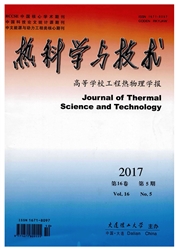

 中文摘要:
中文摘要:
采用热格子-Boltzmann方法,对两平行平板间纳米流体的Rayleigh-Bénard细胞流现象及其影响因素进行数值模拟研究,模型计算结果与方腔内纳米流体的自然对流实验结果吻合较好。讨论了纳米颗粒种类(Al2O3、Cu和SiO2)、体积分数(1%~4%)等因素对细胞流流动和传热的影响。研究发现平板间纳米流体的Rayleigh-Bénard细胞流的流动和传热行为明显异于纯流体,同时发现纳米流体的热导率、黏度和颗粒的热运动共同决定细胞流的流场和温度场分布的规律:热导率越大、布朗运动的越强,会减小流体温度的非均匀性,削弱对流作用,使其细胞流对涡个数减小;黏度增大也会抑制细胞流的发展。
 英文摘要:
英文摘要:
Thermal lattice-Boltzmann method was applied to model the nanofluids's Rayleigh-Benard convection and the influencing factors. The effects of nanoparticles types (Al2O3, Cu, and SiO2), volume fractions (1% to 4%) on Rayleigh-Benard cell flow were discussed. The results show that Rayleigh-B6nard cell flow behaviors of nanofluids are significantly different from those of pure fluids, from the aspects of flow patterns, heat transfer oscillation behaviors and the thermal performance. The thermal conductivity and viscosity, as well as the thermal dynamic motion of nanoparticles play important roles in the development of Rayleigh-B6nard convection within nanofluids. thermal conductivi diameters can be o ty bt and the viscosity in nanofluids, the less vortex pair number, and ained. The larger larger vortex diameters can be obtained.
 同期刊论文项目
同期刊论文项目
 同项目期刊论文
同项目期刊论文
 A 3-D numerical heat transfer model for silica aerogels based on the porous secondary nanoparticle a
A 3-D numerical heat transfer model for silica aerogels based on the porous secondary nanoparticle a Experimental and analytical analyses of the thermal conductivities and high-temperature characterist
Experimental and analytical analyses of the thermal conductivities and high-temperature characterist Wetting kinetics of water nano-droplet containing non-surfactant nanoparticles: A molecular dynamics
Wetting kinetics of water nano-droplet containing non-surfactant nanoparticles: A molecular dynamics Effects of Free Surface Evaporation on Water Nanodroplet Wetting Kinetics: A Molecular Dynamics Stud
Effects of Free Surface Evaporation on Water Nanodroplet Wetting Kinetics: A Molecular Dynamics Stud Effects of solid-gas coupling and pore and particle microstructures on the effective gaseous thermal
Effects of solid-gas coupling and pore and particle microstructures on the effective gaseous thermal 期刊信息
期刊信息
